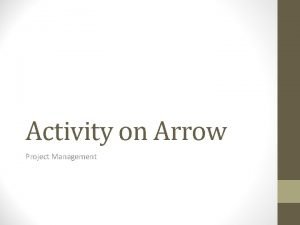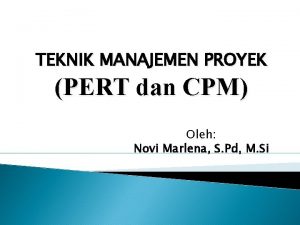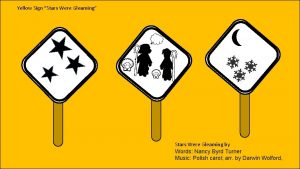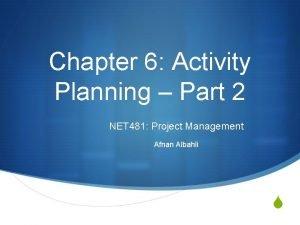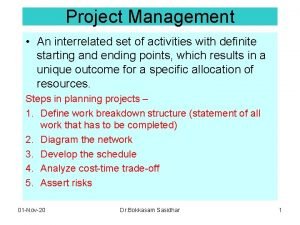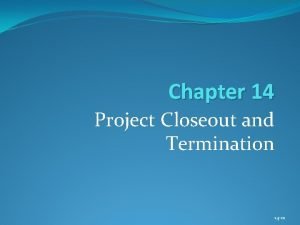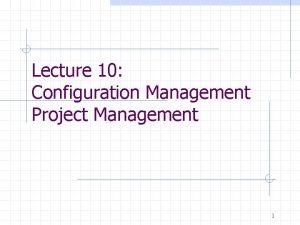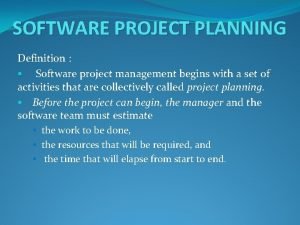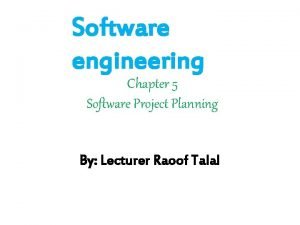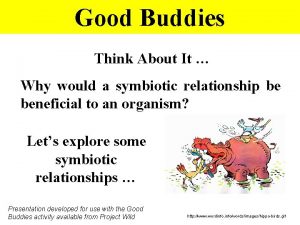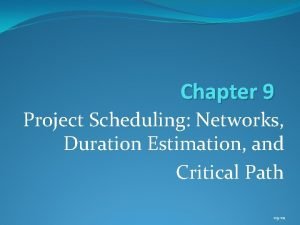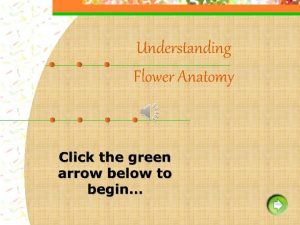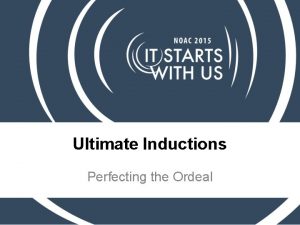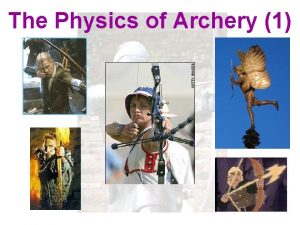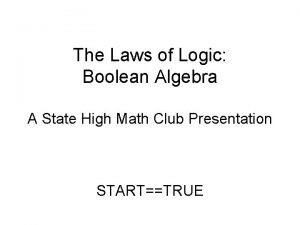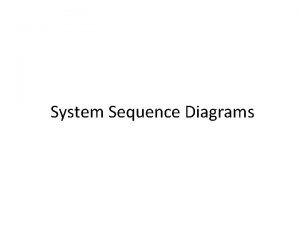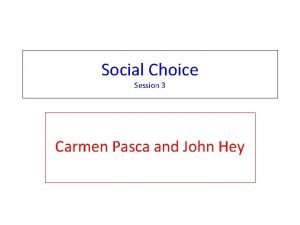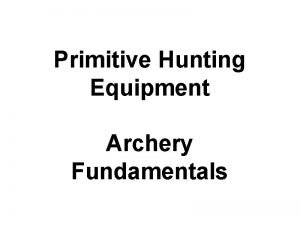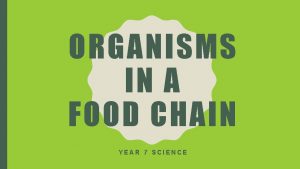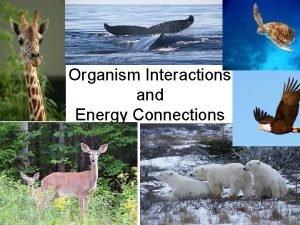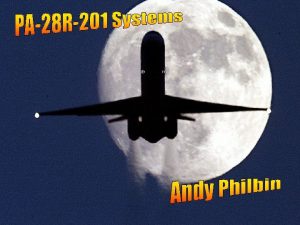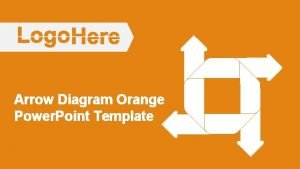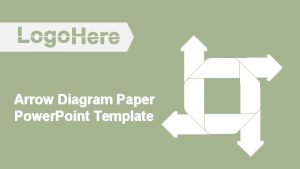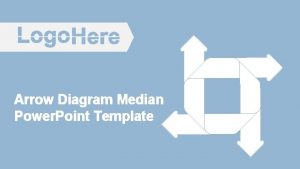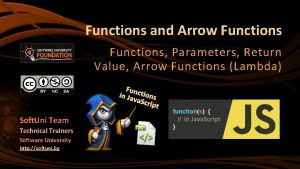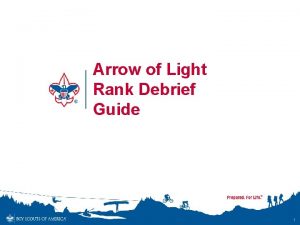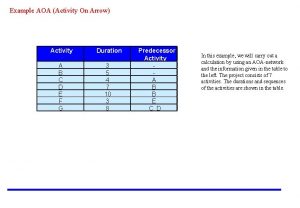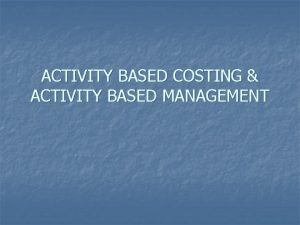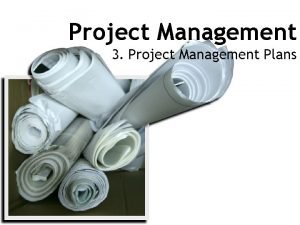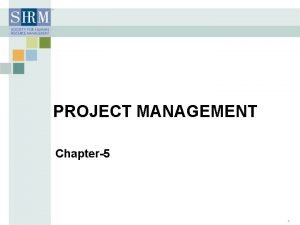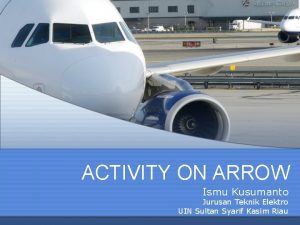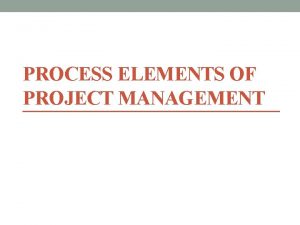Activity on Arrow Project Management Elements of an












































![<Example 12 15 B [6] [7] 10 0 A 0 [5] 20 70 5 <Example 12 15 B [6] [7] 10 0 A 0 [5] 20 70 5](https://slidetodoc.com/presentation_image_h/f9175b323b4e77e3f834e6d1e4d325af/image-45.jpg)





- Slides: 50

Activity on Arrow Project Management

Elements of an Ao. A (Activity-on-Arrow) diagram • Activity (arrow) • Work element or task • Can be real or not real • Name or identification of the tasks (label) must be added • Event (node) • The start and/or finish of one or more activities • Tail (preceding) and head (succeeding) nodes

Conventions • Time flows from left to right • Arrows’ direction • Labels’ order • Head nodes always have a number (or label) higher that of the tail node. This is the same with the arrow labels (alphabetic order). • Activity labels are placed below the arrow (despite the pictures in the textbook), duration of activity is based above the arrow • A network has only one starting and only one ending event. • These conventions are not universal. There are many other to choose from.

Graphical representation • • Arrows, nodes, bending Identification of activities Representation of time Representation of deadlines (external constraints)

Dependency rule b depends on a (b is a successor of a): 12 a 1 2 13 b and c are independent from each other: 1 12 a 13 b 3 8 c 4 2

Consequences of the dependency rule • An event cannot be realised until all activities leading to it are complete. • No activity can start until its tail event is realised.

Merge and burst nodes • Merge nodes: • Events into which a number of activities enter and one (or several) leave. • Burst nodes: • Events that have one (or more) entering activities generating a number of emerging activities.

Two typical errors in logic • Looping: underlying logic must be at fault 5 6 e f g 7 • Dangling: an activity is undertaken with no result 1 start a 2 c b 3 4 5 d end

Interfacing • When an event is common to two or more subnetworks it is said to be an ‘interface’ event between those subnetworks and is represented by a pair of concentric circles. 11 ab 21 13 aa 13 12 22 ba ac bc bb bd 24 24

Milestones • Events which have been identified as being of particular importance in the progress of the project. • Identified by an inverted triangle over the event node (occasionally with an imposed time for the event) 1/1/2014 1 a 2 b 3

Multiple starts and finishes • Only used in computer programs • All starting activities can occur at the start and all finish activities will occur at the end of the project.

Hammock activities • Artificial activities created for the representation of the overhead cost with the aim of cost control. • Embrace activities belong to the same cost centre • Zero duration time (not taking part in the time analysis) • Overhead cost rate is assumed to be constant over the life of the hammock.

Hammock activity 1 12 a 2 1 b 0 h (hammock) 3 2 c 4

Dummy activities • Activities that do not require resources but may in some cases take time. • They are drawn as broken arrows. • They are always subject to the basic dependency rule. • Thre occassions to use dummies: • Identity dummies • Logic dummies • Transit time dummies

Identity dummies • When two or more parallel activities have the same tail and head nodes. 4 1 a b 3 2 3

Logic dummies • When two chains of activities have a common node yet they are at least partly independent of each other. Hint: examine ANY crossroads. • Example: • Activitiy c depends on activity a • Activity d depends on activities a and b • Solution: • separate c from b with a dummy activity

Logic dummy example: 2 4 c 6 e g a 1 8 b 3 d 5 f 7 h

Logic dummy example:

Transit time dummies • If a delay must occur after the competition of an activity before the successor activity can start. 2 2 a 2 4 1 c 1 5 2 b 3 2 d

Overlapping activities • If the activities are not fully discrete • The second activity can start before the first is completed but not before it is at least partly completed. 10 a 1 1 3 a 1 15 b 2 2 7 a 2 3 3 15 b 5

1. Occurrence times of Events = Early and late timings of event occurrence = Early and late event times 21 Earliest Event Activity Time Event Label Head Activity Latest Event 12/7/2020 11: 00 AM <Network Analysis (Computation) Tail Time Standard layout for recording data

<Early Event Time (EET = E =TE) Forward Pass for Computing EET 12/7/2020 11: 00 AM Early Event Time (Earliest occurrence time for event) is the earliest time at which an event can occur, considering the duration of precedent activities. 1. 2. Direction: Left to right, from the beginning to the end of the project Set: EET of the initial node = 0 3. Add: EETj = EETi + Dij 4. Take the maximum The estimated project duration = EET of the last node. i EETi Activity Dij EETj 22 Each activity starts as soon as possible, i. e. , as soon as all of its predecessor activities are completed.

A 10 3 B 20 3 4 C 30 1 8 40 12 23 0 12/7/2020 11: 00 AM <Early Event Times (EET = E =TE)

40 4 12/7/2020 11: 00 AM <Early Event Times (TE) K 70 15 L 80 9 50 12 M 5 24 4 24

<Early Event Times (TE) 20 12/7/2020 11: 00 AM 50 3 25 4 30 10 70 4 5 60 3 40 1 7

<Early Event Times (TE) 50 8 12/7/2020 11: 00 AM 2 3 4 0 30 10 4 70 4 5 60 3 40 3 1 9 7 16 26 20

<Late Event Time (LET = L =TL) 1. 2. Direction: Right to left, from the end to the beginning of the project Set: LET of the last (terminal) node = EET for it 3. Subtract: LETi = LETj - Dij 4. Take the minimum i EETi Activity EETj LETi Dij LETj 27 Backward Pass for Computing LET 12/7/2020 11: 00 AM Late Event Time (Latest occurrence time of event) is the latest time at which an event can occur, if the project is to be completed on schedule.

<Late Event Times (TL) 12/7/2020 11: 00 AM 8 50 13 28 3 16 60 9 16 7 40 9

<Late Event Times (TL) 50 8 12/7/2020 11: 00 AM 2 3 4 01 30 0 4 70 4 5 60 3 40 3 1 9 7 16 29 20

<Late Event Times (TL) 50 10 3 8 12/7/2020 11: 00 AM 2 13 2 3 4 01 30 0 4 70 16 4 5 60 3 9 9 40 3 8 16 1 7 30 20

<Network Analysis (Computation) ESij = EETi 2. Early Finish (EF): (EF) The earliest time at which an activity can be completed. EFij = ESij + Dij 3. Late Finish (LF): (LF) The latest time at which an activity can be completed without delaying project completion. LFij = LETj 4. Late Start (LS): (LS) The latest time at which an activity can be started. LSij = LFij Dij 31 1. Early Start (ES): (ES) The earliest time at which an activity can be started. 12/7/2020 11: 00 AM 2. Activity Times (Schedule)

<Example: Activity Times 50 10 3 8 12/7/2020 11: 00 AM 2 13 2 3 4 01 30 0 4 70 16 32 20 16 4 5 60 3 9 7 9 40 3 8 1 ES 20 -50 = EET 20 = 2 EF 20 -50 = ES + D = 2 + 3 = 5 LF 20 -50 = LET 50 = 13 LS 20 -50 = LF – D = 13 – 3 = 10

<Network Analysis (Computation) q Total float or path float is the amount of time that an activity’s completion may be delayed without extending project completion time. q Total float floa or path float is the amount of time that an activity’s completion may be delayed without affecting the earliest start of any activity on the network critical path. 33 1. Total Float (TF) 12/7/2020 11: 00 AM 3. Activity Floats

<Network Analysis (Computation) q Total path float time for activity (i-j) is the total float associated with a path. q For arbitrary activity (i j), the total float can be written as: Path Float =Total Float (TFij) = LSij ESij = LFij EFij = LETj – EETi Dij 34 1. Total Float (TF) 12/7/2020 11: 00 AM 3. Activity Floats

<Example: Total Float Times 50 10 3 8 12/7/2020 11: 00 AM 2 13 3 2 4 01 30 0 4 70 16 35 20 16 4 5 60 3 40 3 8 9 9 1 7 TF 20 -50 = LS 20 -50 - ES 20 -50 TF 20 -50 = 10 – 2 = 8 TF 20 -50 = LF 20 -50 - EF 20 -50 TF 20 -50 = 13 – 5 = 8 TF 20 -50 = LET 50 – EET 20 - D 20 -50 TF 20 -50 = 13 – 2 - 3 = 8

<Network Analysis (Computation) 2. Free Float (FF) 36 q Free float or activity float is the amount of time that an activity’s completion time may be delayed without affecting the earliest start of succeeding activity. 12/7/2020 11: 00 AM 3. Activity Floats q Activity float is “owned” by an individual activity, whereas path or total float is shared by all activities along a slack path. q Total float equals or exceeds free float (TF ≥ FF). q For arbitrary activity (i j), the free float can be written as: Activity Float = Free Float (FFij) = ESjk EFij = EETj – EETi Dij

<Example: Free Float Times 50 10 3 8 12/7/2020 11: 00 AM 2 13 3 2 4 01 30 0 4 70 16 37 20 16 4 5 60 3 40 3 8 9 7 9 1 FF 20 -50 = ES 50 -70 - EF 20 -50 FF 20 -50 = 8 – 5 = 3 FF 20 -50 = EET 50 – EET 20 - D 20 -50 FF 20 -50 = 8 – 2 - 3 = 3

<Network Analysis (Computation) q Interfering float is the difference between TF and FF. q If ITF of an activity is used, the start of some succeeding activities will be delayed beyond its ES. q In other words, if the activity uses its ITF, it “interferes” by this amount with the early times for the down path activity. q For arbitrary activity (i j), the Interfering float can be written as: Interfering Float (ITFij) = TFij FFij = LETj EETj 38 3. Interfering Float (ITF) 12/7/2020 11: 00 AM 3. Activity Floats

<Example: Interfering Float Times 50 10 3 8 12/7/2020 11: 00 AM 2 13 3 2 4 01 30 0 4 70 16 16 4 5 60 3 40 3 8 9 7 9 1 ITF 20 -50 = TF 20 -50 - FF 20 -50 IFF 20 -50 = 8 – 3 = 5 ITF 20 -50 = LET 50 – EET 50 ITF 20 -50 = 13 – 8 = 5 39 20

<Network Analysis (Computation) q It is the amount of float which an activity will always possess no matter how early or late it or its predecessors and successors are. q The activity has this float “independent” of any slippage of predecessors and any allowable start time of successors. Assuming all predecessors end as late as possible and successors start as early as possible q IDF is “owned” by one activity. q In all cases, independent float is always less than or equal to free float (IDF ≤ FF). 40 4. Independent Float (IDF) 12/7/2020 11: 00 AM 3. Activity Floats

<Network Analysis (Computation) q For arbitrary activity (i j), the Independent Float can be written as: Independent Float (IDFij) = Max (0, EETj LETi – Dij) = Max (0, Min (ESjk) - Max (LFli) Dij) 41 4. Independent Float (IDF) 12/7/2020 11: 00 AM 3. Activity Floats

<Example: Independent Float Times 50 10 3 8 12/7/2020 11: 00 AM 2 13 3 2 4 01 30 0 4 70 16 42 20 16 4 5 60 3 40 3 8 9 7 9 1 IDF 20 -50 = Max. (0, [EET 50 – LET 20 - D 20 -50]) IDF 20 -50 = Max. (0, [8 – 10 – 3]) = 0

<Network Analysis (Computation) 5. Subcritical Paths q Subcritical paths have varying degree of path float and hence depart from criticality by varying amounts. q Subcritical paths can be found in the following way: 1. 2. 3. Sort the activities in the network by their path float, placing those activities with a common path float in the same group. Order the activities within a group by early start time. Order the groups according to the magnitude of their path float, small values first. 43 q Critical path is the path with the least total float = The longest path through the network 12/7/2020 11: 00 AM 4. Critical Path

Draw an arrow diagram to represent the following project. Calculate occurrence times of events, activity times, and activity floats. Also determine the critical path and the degree of criticality of other float paths. Activity A B C D E F G H I Preceding Activity None A A A B D E, C, F G G Time (days) 5 7 4 8 6 8 3 4 6 12/7/2020 11: 00 AM <Example 44
![Example 12 15 B 6 7 10 0 A 0 5 20 70 5 <Example 12 15 B [6] [7] 10 0 A 0 [5] 20 70 5](https://slidetodoc.com/presentation_image_h/f9175b323b4e77e3f834e6d1e4d325af/image-45.jpg)
<Example 12 15 B [6] [7] 10 0 A 0 [5] 20 70 5 C 5 [4] E F [8] 40 13 13 30 H [4] 50 D 28 21 G 21 [3] 60 45 30 12/7/2020 11: 00 AM Activity on arrow network and occurrence times of events 24 I 24 6 80 30 30

<Example Activity A B C D E F G H I ES EF LF LS TF FF ITF IDF 0 5 5 5 12 13 21 24 24 5 12 9 13 18 21 24 28 30 5 15 21 13 21 21 24 30 30 0 8 17 5 15 13 21 26 24 0 3 12 0 3 0 0 2 0 0 0 12 0 3 0 0 2 0 0 3 0 0 0 0 0 12 0 0 2 0 12/7/2020 11: 00 AM Activity times and activity floats 46

<Example Activity A D F G I H B E C ES EF LF LS TF 0 5 13 21 24 24 5 12 5 5 13 21 24 30 28 12 18 9 5 13 21 24 30 30 15 21 21 0 5 13 21 24 26 8 15 17 0 0 0 2 3 3 12 Criticality Critical Path 12/7/2020 11: 00 AM Critical path and subcritical paths a “near critical” path Third most critical path Path having most float 47

<Case Study Activity Description 100 Inspect the machine after installation 200 Hire the operator 300 Install the new machine 400 Inspect and store the machine after delivery 500 Hire labor to install the new machine 600 Train the operator 700 Order and deliver the new machine Depends on Level Duration (day) 300 4 1 None 1 25 500, 400 3 2 700 2 1 None 1 20 200, 300 4 3 None 1 30 48 Activity Code 12/7/2020 11: 00 AM Installation of a new machine and training the operator

< Case Study: Installation of a New Machine and Training the Operator 50 25 30 e m rde ac r hi & ne de liv er th e 1 0 Hire labor to install the new machine 20 O In af spe ter ct de the liv m er a y ch in 10 0 20 30 30 31 Inst all 2 the m. 33 40 33 Inspe ct the m. 1 49 3 the e Hir ator oper e th ain tor Tr era op 33 12/7/2020 11: 00 AM 33 36 60 36

< Case Study: Installation of a New Machine and Training the Operator Activity times and activity floats Activity i-j number ES Hire the operator 10 -50 0 Hire labor to install the machine 10 -30 0 Order and deliver the machine 10 -20 0 Inspect the m. after delivery 20 -30 30 Install the machine 30 -40 31 Inspect the machine 40 -60 33 Train the operator 50 -60 33 § § EF LS LF TF FF 25 8 33 8 8 20 11 31 11 11 30 0 0 31 30 31 0 0 33 31 33 0 0 34 35 36 2 2 36 33 36 0 0 ITF 0 0 0 0 IDF 8 11 0 0 0 2 0 12/7/2020 11: 00 AM § Critical path: 10 -20, 20 -30, 30 -40, 50 -60. Near critical path: 40 -60 Third most critical path: 10 -50 Path having most float: 10 -30 50
 Aoa in project management
Aoa in project management Activity on arrow شرح
Activity on arrow شرح Aoa activity on arrow
Aoa activity on arrow Simbol yang menyatakan sebuah dummy adalah
Simbol yang menyatakan sebuah dummy adalah Introduction for project
Introduction for project Ipsd 204 accelerated math
Ipsd 204 accelerated math Project star gleaming arrow
Project star gleaming arrow Project arrow math test
Project arrow math test Activity based approach in software project management
Activity based approach in software project management Software project management lectures
Software project management lectures Concurrent activity in project management
Concurrent activity in project management Project close out
Project close out The role of project management in achieving project success
The role of project management in achieving project success Modern project profiles in spm
Modern project profiles in spm Reducing project duration examples
Reducing project duration examples Introduction to project management kathy schwalbe
Introduction to project management kathy schwalbe Software project evaluation
Software project evaluation Types of project audit in project management
Types of project audit in project management Agile ms project template
Agile ms project template Types of project termination in project management
Types of project termination in project management Activity 2 limiting reactants activity
Activity 2 limiting reactants activity Debye huckel limiting law
Debye huckel limiting law Form content and use
Form content and use Activity 1 activity 2
Activity 1 activity 2 Activity 2 plus and minus
Activity 2 plus and minus Activity 2:
Activity 2: Asset management vs project management
Asset management vs project management Configuration management project management
Configuration management project management Principles of cost management
Principles of cost management Ieee 828
Ieee 828 Project integration management
Project integration management Periodic table color activity
Periodic table color activity Periodic table coloring activity key
Periodic table coloring activity key What is first activity in software project planning
What is first activity in software project planning What is the first activity in software project planning?
What is the first activity in software project planning? Good buddies worksheet
Good buddies worksheet Wrasse and bass relationship
Wrasse and bass relationship Burst activity
Burst activity The most obvious part of a flower
The most obvious part of a flower Spirit of the arrow booklets
Spirit of the arrow booklets Downward arrow technique
Downward arrow technique Physics of archery
Physics of archery Pierce arrow logic
Pierce arrow logic Impossibilidade de arrow
Impossibilidade de arrow Advancedseq
Advancedseq Arrow's theorem
Arrow's theorem Draw an arrow from the pronoun to its antecedent
Draw an arrow from the pronoun to its antecedent Slotted plastic tip on arrow
Slotted plastic tip on arrow Range cards and sector sketches
Range cards and sector sketches Beetle aphid bird food chain
Beetle aphid bird food chain Food chain with labels
Food chain with labels

